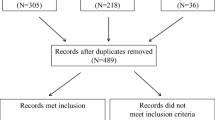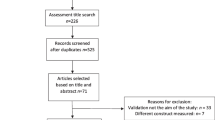Abstract
Unusual sensory experiences are commonly seen in people with Asperger syndrome (AS). They correlate with functional impairments and cause distress. The current study investigates how these experiences have affected nine adults with AS’s lives, as well as the coping strategies utilised. Semi-structured interviews were conducted using Instant Messaging software. Data were analysed using Grounded Theory. A number of inter-related categories and focused codes were identified. The categories included heightened senses, sensory stress, the stress avalanche, moderating factors, coping strategies, other people, self-acceptance, fascination, and isolation. A model was constructed as to how these categories and codes interact. How these findings link with previous research into autism spectrum disorders is discussed. Implications for services and future research are also made.


Similar content being viewed by others
Notes
* ntps: neurotypicals: a commonly-used word by people with Asperger Syndrome to describe those without an autistic spectrum disorder.
References
American Psychiatric Association. (1994). Diagnostic and statistical manual of mental disorders. Washington DC: American Psychiatric Association.
Baker, A. E., Lane, A., Angley, M. T., & Young, R. L. (2008). The relationship between sensory processing patterns and behavioural responsiveness in autistic disorder: A pilot study. Journal of Autism and Developmental Disorders, 38(5), 867–875. doi:10.1007/s10803-007-0459-0.
Baranek, G. T. (2002). Efficacy of sensory and motor interventions for children with autism. Journal of Autism and Developmental Disorders, 32(5), 397–422. doi:10.1023/A:1020541906063.
Baranek, G. T., Boyd, B. A., Poe, M. D., David, F. J., & Watson, L. R. (2007). Hyperresponsive sensory patterns in young children with autism. American Journal on Mental Retardation, 112(4), 233–245. doi:10.1352/0895-8017(2007)112[233:HSPIYC]2.0.CO;2.
Baranek, G. T., David, F. J., Poe, M. D., Stone, W. L., & Watson, L. R. (2006). Sensory experiences questionnaire: Discriminating sensory features in young children with autism, developmental delay, and typical development. Journal of Child Psychiatry and Psychiatry, 47, 591–601. doi:10.1111/j.1469-7610.2005.01546.x.
Baron-Cohen, S., Ashwin, E., Ashwin, C., Tavassoli, T., & Chakrabarti, B. (2009). Talent in Autism: Hyper-systemizing, hyper-attention to detail and sensory hypersensitivity. Phil. Trans. R. Soc., 364, 1377–1383. doi:10.1098/rstb.2008.0337.
Baron-Cohen, S., Wheelwright, S., Robinson, J., & Woodbury-Smith, M. (2005). The Adult Asperger Assessment (AAA): A diagnostic method. Journal of Autism and Developmental Disorders, 35(6), 807–819.
Ben-Sasson, A., Hen, L., Fluss, R., Cermak, S. A., Engel-Yeger, B., & Gal, E. (2009). A meta-analysis of sensory modulation symptoms in individuals with autism spectrum disorders. Journal of Autism and Developmental Disorders, 39, 1–11. doi:10.1007/s10803-008-0593-3.
Bronsard, G., Botbol, M., & Tordjman, S. (2010). Aggression in low functioning children and adolescents with autistic disorder. PLoS ONE, 5(12). doi:10.1371/journal.pone.0014358.
Brown, N. B., & Dunn, W. (2010). Relationship between context and sensory processing in children with autism. American Journal of Occupational Therapy, 64, 474–483. doi:10.5014/ajot.2010.09077.
Brugha, T. S., McManus, S., Bankart, J., Scott, F., Purdon, S., Smith, J., et al. (2011). Epidemiology of autism spectrum disorders in adults in the community in England. Archives of General Psychiatry, 68(5), 459–465. doi:10.1001/archgenpsychiatry.2011.38.
Carrington, S., & Graham, L. (2001). Perceptions of school by two teenage boys with Asperger syndrome and their mothers: A qualitative study. Autism, 5(1), 37–48. doi:10.1177/1362361301005001004.
Cesaroni, L., & Garber, M. (1991). Exploring the experience of autism through firsthand accounts. Journal of Autism and Developmental Disorders, 21(3), 303–313. doi:10.1007/BF02207327.
Chamak, B., Bonniau, B., Jaunay, E., & Cohen, D. (2008). What can we learn about autism from autistic persons? Psychotherapy and Psychosomatics, 77(5), 271–279. doi:10.1159/000140086.
Charmaz, K. (2006). Constructing grounded theory: A practical gudie through qualitative analysis. London: SAGE.
Chen, Y. H., Rodgers, J., & McConachie, H. (2009). Restricted and repetitive behaviours, sensory processing and cognitive style in children with autism spectrum disorders. Journal of Autism and Developmental Disorders, 39, 635–642. doi:10.1007/s10803-008-0663-6.
Cutcliffe, J. R. (2005). Adapt or adopt: Developing and transgressing the methodological boundaries of grounded theory. Journal of Advanced Nursing, 51, 421–428. doi:10.1111/j.1365-2648.2005.03514.x.
Davidson, J. (2008). Autistic culture online: Virtual communication and cultural expression on the spectrum. Social and Cultural Geography, 9(7), 791–806. doi:10.1080/14649360802382586.
Department of Health. (2010). Rewarding and fulfilling lives: The strategy for adults with autism in England. Retrieved from: http://www.dh.gov.uk/en/Publicationsandstatistics/Publications/PublicationsPolicyAndGuidance/DH_113369.
Dunn, W. (1999). Sensory profile: User’s manual San Antonio. TX: The Psychological Corporation.
Elliott, R., Fischer, C. T., & Rennie, D. L. (1999). Evolving guidelines for publication of qualitative research studies in psychology and related fields. British Journal of Clinical Psychology, 38(3), 215–229. doi:10.1348/014466599162782.
Escalona, A., Field, T., Singer-Strunck, R., Cullen, C., & Hartshorn, K. (2001). Improvements in the behavior of children with autism following massage therapy. Journal of Autism and Developmental Disorders, 31, 513–516. doi:10.1023/A:1012273110194.
Fleisher, M. (2001). Autism: An insider’s account. In J. Richer (Ed.), Autism: The search for coherence. London: Jessica Kingsley Publishers.
Foss-Feig, J. H., Heacock, J. L., & Cascio, C. J. (2012). Tactile responsiveness patterns and their association with core features in autism spectrum disorders. Research in Autism Spectrum Disorders, 6, 337–344. doi:10.1016/j.rasd.2011.06.007.
Frith, U. (1989). A new look at language and communication in autism. British Journal of Disorders of Communication, 24(2), 123–150. doi:10.3109/13682828909011952.
Gabriels, R. L., Agnew, J. A., Miller, L. J., Gralla, J., Pan, Z., Goldson, E., et al. (2008). Is there a relationship between restricted, repetitive, stereotyped behaviors and interests and abnormal sensory response in children with autism spectrum disorders? Research in Autism Spectrum Disorders, 2(4), 660–670. doi:10.1016/j.rasd.2008.02.002.
Green, S. A., & Ben-Sasson, A. (2010). Anxiety disorders and sensory over-responsivity in children with autism spectrum disorders: Is there a causal relationship? Journal of Autism and Developmental Disorders, 40(12), 1495–1504. doi:10.1007/s10803-010-1007-x.
Humphrey, N., & Lewis, S. (2008). ‘Make me normal’: The views and experiences of pupils on the autistic spectrum in mainstream secondary schools. Autism, 12(1), 23–46. doi:10.1177/1362361307085267.
Jantz, K. M. (2011). Support groups for adults with Asperger syndrome. Focus on Autism and Other Developmental Disabilities, 26(2), 119–128. doi:10.1177/1088357611406903.
Jobe, L. E., & Williams White, S. (2007). Loneliness, social relationships, and a broader autism phenotype in college students. Personality and Individual Differences, 42(8), 1479–1489. doi:10.1016/j.paid.2006.10.021.
Jones, R. S. P., & Meldal, T. O. (2001). Social relationships and Asperger’s syndrome: A qualitative analysis of first-hand accounts. Journal of Learning Disabilities, 5(1), 35–41.
Jones, R. S. P., Quigney, C., & Huws, J. C. (2003). First-hand accounts of sensory perceptual experiences in autism: A qualitative analysis. Journal of Intellectual and Developmental Disability, 28(2), 112–121. doi:10.1080/1366825031000147058.
Kazmer, M. M., & Xie, B. (2008). Qualitative interviewing in Internet studies: Playing with the media, playing with the method. Information, Communication and Society, 11(2), 257–278.
Kern, J. K., Trivedi, M. H., Garver, C. R., Grannemann, B. D., Andrews, A. A., Savla, J. S., et al. (2006). The pattern of sensory processing abnormalities in autism. Autism, 10(5), 480–494. doi:10.1177/1362361306066564.
Konstantareas, M. M., & Stewart, K. (2006). Affect regulation and temperament in children with autism spectrum disorder. Journal of Autism and Developmental Disorders, 36(2), 143–154. doi:10.1007/s10803-005-0051-4.
Kuusikko, S., Pollock-Wurman, R., Jussila, K., Carter, A. S., Mattila, M. L., Ebeling, H., et al. (2008). Social anxiety in high-functioning children and adolescents with autism and Asperger syndrome. Journal of Autism and Developmental Disorders, 38(9), 1697–1709. doi:10.1007/s10803-008-0555-9.
Lane, A. E., Young, R. L., Baker, A. E., & Angley, M. T. (2010). Sensory processing subtypes in autism: Association with adaptive behavior. J. Autism Dev Disorder, 40(1), 112–122.
Liss, M., Saulnier, C., Fein, D., & Kinsbourne, M. (2006). Sensory and attention abnormalities in autistic spectrum disorders. Autism, 10(2), 155–172. doi:10.1177/1362361306062021.
Locke, J., Ishijima, E. H., Kasari, C., & London, N. (2010). Loneliness, friendship quality and the social networks of adolescents with high-functioning autism in an inclusive school setting. Journal of Research in Special Educational Needs, 10(2), 74–81. doi:10.1111/j.1471-3802.2010.01148.x.
McDougle, C. J., Scahill, L., Aman, M. G., McCracken, J. T., Tierney, E., Davies, M., et al. (2005). Risperidone for the core symptom domains of autism: Results from the study by the Autism Network of the Research Units on Pediatric Psychopharmacology. American Journal of Psychiatry, 162(6), 1142–1148. doi:10.1176/appi.ajp.162.6.1142.
Miral, S., Gencer, O., Inal-Emiroglu, F. N., Baykara, B., Baykara, A., & Dirik, E. (2008). Risperidone versus haloperidol in children and adolescents with AD: A randomized, controlled, double-blind trial. European Child and Adolescent Psychiatry, 17(1), 1–8. doi:10.1007/s00787-007-0620-5.
Muller, E., Schuler, A., & Yates, G. B. (2008). Social challenges and supports from the perspective of individuals with Asperger syndrome and other autism spectrum disabilities. Autism, 12(2), 173–190. doi:10.1177/1362361307086664.
National Audit Office (2009). Supporting adults with autism through adulthood. Retrieved from http://www.nao.org.uk/publications/0809/autism.aspx.
Piravej, K., Tangtrongchitr, P., Chandarasiri, P., Paothong, L., & Sukprasong, S. (2009). Effects of thai traditional massage on autistic children’s behavior. Journal of Alternative and Complementary Medicine, 15(12), 1355–1361. doi:10.1089/acm.2009.0258.
Punshon, C., Skirrow, P., & Murphy, G. (2009). The ‘not guilty verdict’: Psychological reactions to a diagnosis of Asperger syndrome in adulthood. Autism, 13(3), 265–283. doi:10.1177/1362361309103795.
Silva, L. M. T., Schalock, M., Ayres, R., Bunse, C., & Budden, S. (2009). Qigong massage treatment for sensory and self-regulation problems in young children with autism: A randomized controlled trial. American Journal of Occupational Therapy, 63(4), 423–432.
Singer, J. (1999). ‘Why can’t you be normal for once in your life?’ From a ‘problem with no name’ to the emergence of a new category of difference. In M. Corker & S. French (Eds.), Disability discourse (pp. 59–67). Buckingham: Open University Press.
Stieger, S., & Goritz, A. S. (2006). Using Instant Messaging for internet-based interviews. Cyberpsychology and Behavior, 9(5), 552–559. doi:10.1089/cpb.2006.9.552.
Tomchek, S. D., & Dunn, W. (2007). Sensory processing in children with and without autism: A comparative study using the short sensory profile. American Journal of Occupational Therapy, 61(2), 190–200. doi:10.5014/ajot.61.2.190.
White, S. W., & Roberson-Nay, R. (2009). Anxiety, social deficits, and loneliness in youth with autism spectrum disorders. Journal of Autism and Developmental Disorders, 39(7), 1006–1013. doi:10.1007/s10803-009-0713-8.
Wing, L., Leekam, S. R., Libby, S. J., Gould, J., & Larcombe, M. (2002). The diagnostic interview for social and communication disorders: Background, inter-rater reliability and clinical use. Journal of Child Psychology and Psychiatry, 43(3), 307–325.
Acknowledgments
Great thanks goes to the participants for their honesty and eloquence. Many thanks to Dr Krysia Canvin, Department of Psychiatry, University of Oxford, for all her invaluable help and infectious enthusiasm making the study a Grounded theory one. Thanks also to Dr Myra Cooper, Oxford Institute of Clinical Psychology, for her advice throughout the process. This paper is based on research forming part of a doctorate in Clinical Psychology.
Author information
Authors and Affiliations
Corresponding author
Additional information
Dr. Richard S. Smith formerly worked at Oxford Institute of Clinical Psychology, University of Oxford and Oxford Health Foundation Trust, Oxford, England, where the research was conducted.
Rights and permissions
About this article
Cite this article
Smith, R.S., Sharp, J. Fascination and Isolation: A Grounded Theory Exploration of Unusual Sensory Experiences in Adults with Asperger Syndrome. J Autism Dev Disord 43, 891–910 (2013). https://doi.org/10.1007/s10803-012-1633-6
Published:
Issue Date:
DOI: https://doi.org/10.1007/s10803-012-1633-6




